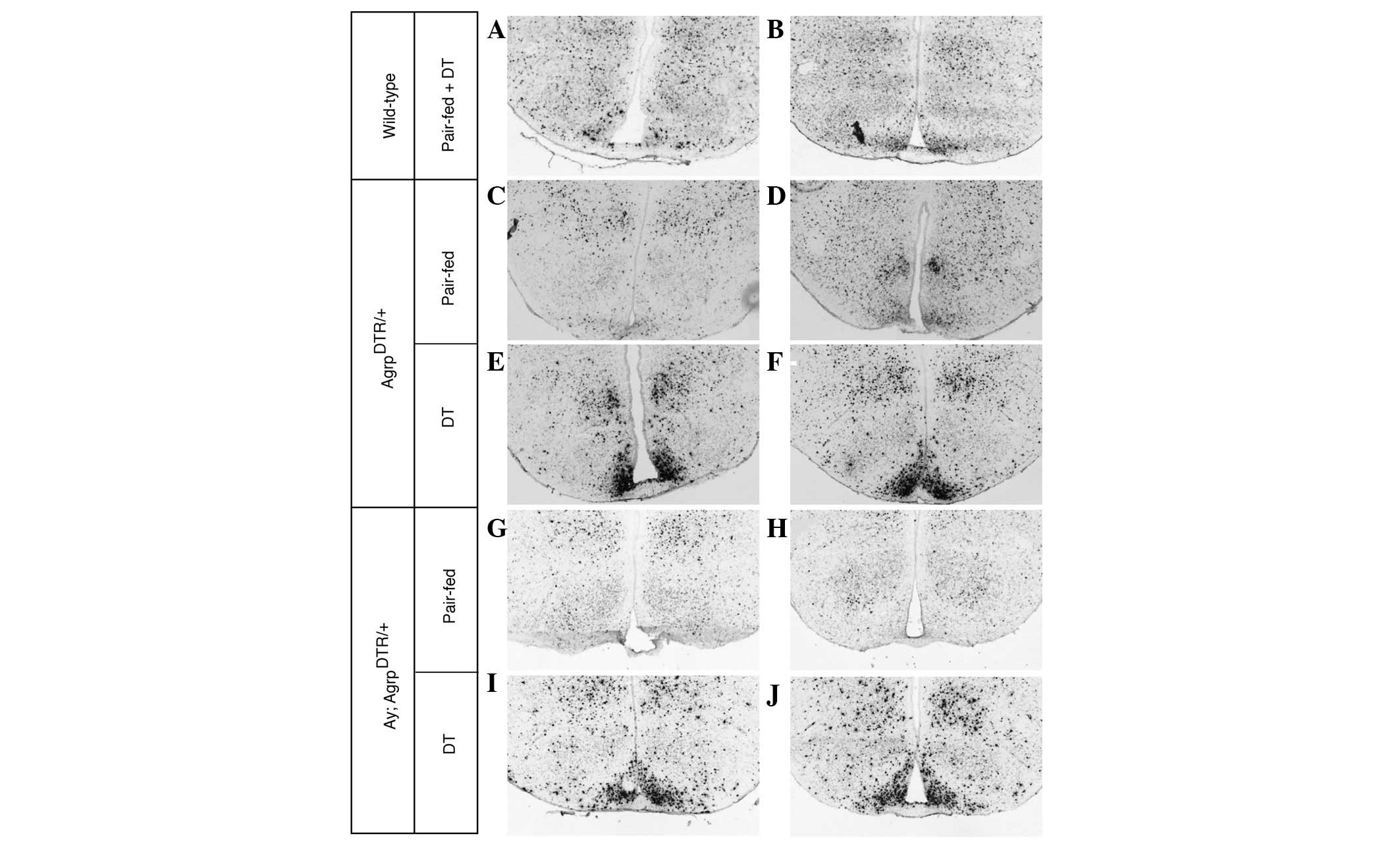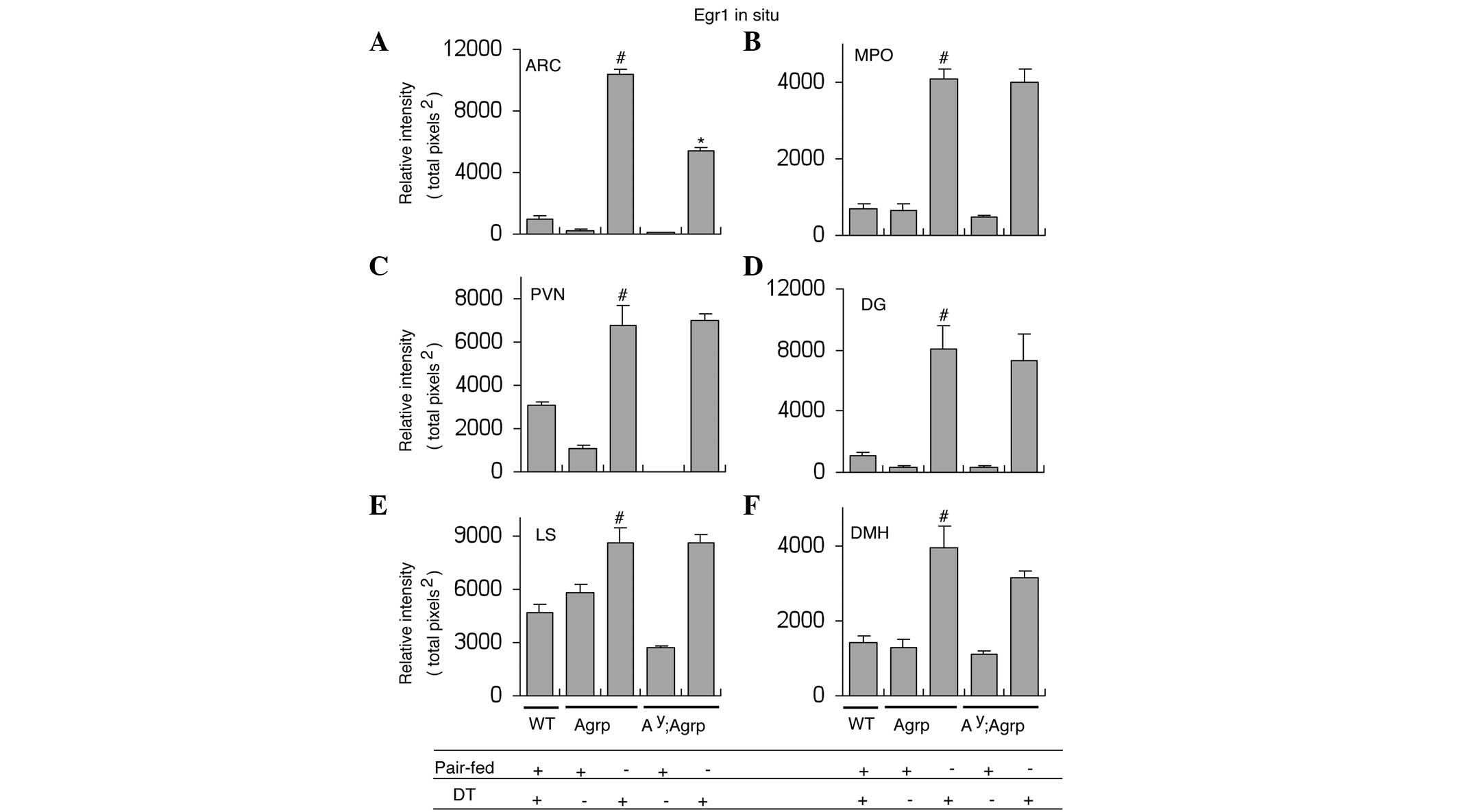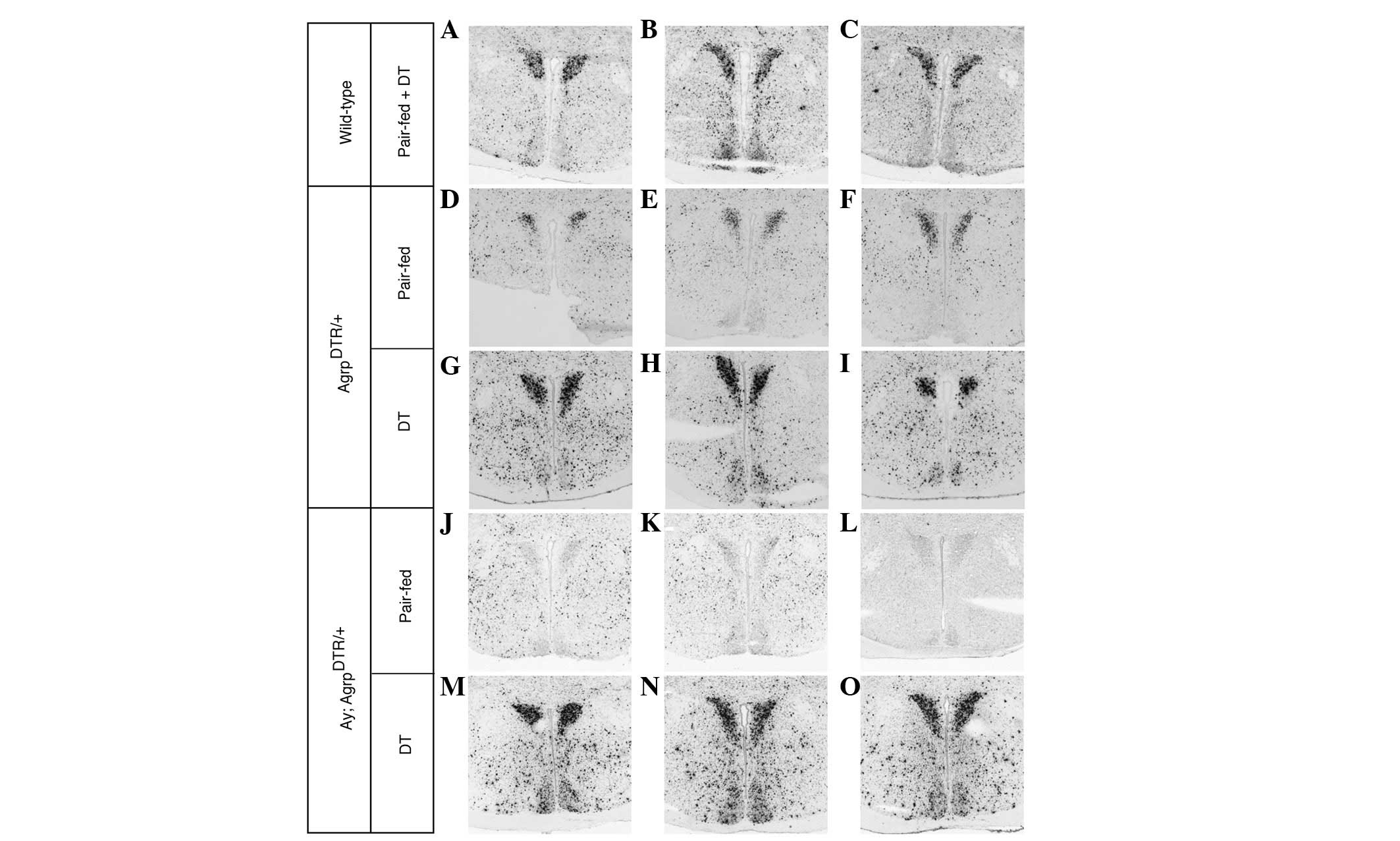|
1
|
Rossi M, Kim MS, Morgan DG, Small CJ,
Edwards CM, Sunter D, Abusnana S, Goldstone AP, Russell SH, Stanley
SA, et al: A C-terminal fragment of Agouti-related protein
increases feeding and antagonizes the effect of alpha-melanocyte
stimulating hormone in vivo. Endocrinology. 139:4428–4431. 1998.
View Article : Google Scholar
|
|
2
|
Broberger C, Johansen J, Johansson C,
Schalling M and Hökfelt T: The neuropeptide Y/agouti gene-related
protein (AGRP) brain circuitry in normal, anorectic, and monosodium
glutamate-treated mice. Proc Natl Acad Sci USA. 95:15043–15048.
1998. View Article : Google Scholar : PubMed/NCBI
|
|
3
|
Haskell-Luevano C, Chen P, Li C, Chang K,
Smith MS, Cameron JL and Cone RD: Characterization of the
neuroanatomical distribution of agouti-related protein
immunoreactivity in the rhesus monkey and the rat. Endocrinology.
140:1408–1415. 1999.PubMed/NCBI
|
|
4
|
Kim MS, Rossi M, Abusnana S, Sunter D,
Morgan DG, Small CJ, Edwards CM, Heath MM, Stanley SA, Seal LJ, et
al: Hypothalamic localization of the feeding effect of
agouti-related peptide and alpha-melanocyte-stimulating hormone.
Diabetes. 49:177–182. 2000. View Article : Google Scholar : PubMed/NCBI
|
|
5
|
Morton GJ, Cummings DE, Baskin DG, Barsh
GS and Schwartz MW: Central nervous system control of food intake
and body weight. Nature. 443:289–295. 2006. View Article : Google Scholar : PubMed/NCBI
|
|
6
|
Barsh GS and Schwartz MW: Genetic
approaches to studying energy balance: perception and integration.
Nat Rev Genet. 3:589–600. 2002.PubMed/NCBI
|
|
7
|
Kalra SP, Dube MG, Pu S, Xu B, Horvath TL
and Kalra PS: Interacting appetite-regulating pathways in the
hypothalamic regulation of body weight. Endocr Rev. 20:68–100.
1999.PubMed/NCBI
|
|
8
|
Ollmann MM, Wilson BD, Yang YK, Kerns JA,
Chen Y, Gantz I and Barsh GS: Antagonism of central melanocortin
receptors in vitro and in vivo by agouti-related protein. Science.
278:135–138. 1997. View Article : Google Scholar : PubMed/NCBI
|
|
9
|
Luquet S, Perez FA, Hnasko TS and Palmiter
RD: NPY/AgRP neurons are essential for feeding in adult mice but
can be ablated in neonates. Science. 310:683–685. 2005. View Article : Google Scholar : PubMed/NCBI
|
|
10
|
Gropp E, Shanabrough M, Borok E, Xu AW,
Janoschek R, Buch T, Plum L, Balthasar N, Hampel B, Waisman A, et
al: Agouti-related peptide-expressing neurons are mandatory for
feeding. Nat Neurosci. 8:1289–1291. 2005. View Article : Google Scholar : PubMed/NCBI
|
|
11
|
Bewick GA, Gardiner JV, Dhillo WS, Kent
AS, White NE, Webster Z, Ghatei MA and Bloom SR: Post-embryonic
ablation of AgRP neurons in mice leads to a lean, hypophagic
phenotype. FASEB J. 19:1680–1682. 2005.PubMed/NCBI
|
|
12
|
Xu AW, Kaelin CB, Morton GJ, Ogimoto K,
Stanhope K, Graham J, Baskin DG, Havel P, Schwartz MW and Barsh GS:
Effects of hypothalamic neurodegeneration on energy balance. PLoS
Biol. 3:e4152005. View Article : Google Scholar : PubMed/NCBI
|
|
13
|
Wu Q, Boyle MP and Palmiter RD: Loss of
GABAergic signaling by AgRP neurons to the parabrachial nucleus
leads to starvation. Cell. 137:1225–1234. 2009. View Article : Google Scholar : PubMed/NCBI
|
|
14
|
Sukhatme VP, Cao XM, Chang LC, Tsai-Morris
CH, Stamenkovich D, Ferreira PC, Cohen DR, Edwards SA, Shows TB,
Curran T, et al: A zinc finger-encoding gene coregulated with c-fos
during growth and differentiation, and after cellular
depolarization. Cell. 53:37–43. 1988. View Article : Google Scholar : PubMed/NCBI
|
|
15
|
Cole AJ, Saffen DW, Baraban JM and Worley
PF: Rapid increase of an immediate early gene messenger RNA in
hippocampal neurons by synaptic NMDA receptor activation. Nature.
340:474–476. 1989. View
Article : Google Scholar : PubMed/NCBI
|
|
16
|
Beckmann AM and Wilce PA: Egr
transcription factors in the nervous system. Neurochem Int.
31:477–510; discussion 517–476. 1997. View Article : Google Scholar
|
|
17
|
de Lartigue G, Lur G, Dimaline R, Varro A,
Raybould H and Dockray GJ: EGR1 Is a target for cooperative
interactions between cholecystokinin and leptin, and inhibition by
ghrelin, in vagal afferent neurons. Endocrinology. 151:3589–3599.
2010.PubMed/NCBI
|
|
18
|
Cone RD: Anatomy and regulation of the
central melanocortin system. Nat Neurosci. 8:571–578. 2005.
View Article : Google Scholar : PubMed/NCBI
|
|
19
|
Michaud EJ, Bultman SJ, Stubbs LJ and
Woychik RP: The embryonic lethality of homozygous lethal yellow
mice (Ay/Ay) is associated with the disruption of a novel
RNA-binding protein. Genes Dev. 7:1203–1213. 1993. View Article : Google Scholar : PubMed/NCBI
|
|
20
|
Aher CV, Duwaerts CC, Akama KT and Lucas
LR: Effects of acute diuresis stress on egr-1 (zif268) mRNA levels
in brain regions associated with motivated behavior. Brain Res
Bull. 81:114–119. 2010. View Article : Google Scholar : PubMed/NCBI
|
|
21
|
Paxinos G and Franklin KBJ: The Mouse
Brain in Stereotaxic Coordinates. 2nd edition. Academic Press;
Waltham, MA: 2001
|
|
22
|
Liu T, Wang Q, Berglund ED and Tong Q:
Action of neurotransmitter: A key to unlock the AgRP neuron feeding
circuit. Front Neurosci. 6:2002013.PubMed/NCBI
|
|
23
|
Dockray GJ and Burdyga G: Plasticity in
vagal afferent neurones during feeding and fasting: mechanisms and
significance. Acta Physiol (Oxf). 201:313–321. 2011. View Article : Google Scholar : PubMed/NCBI
|
|
24
|
Rogge G, Jones D, Hubert GW, Lin Y and
Kuhar MJ: CART peptides: regulators of body weight, reward and
other functions. Nat Rev Neurosci. 9:747–758. 2008. View Article : Google Scholar : PubMed/NCBI
|
|
25
|
Koylu EO, Couceyro PR, Lambert PD, Ling
NC, DeSouza EB and Kuhar MJ: Immunohistochemical localization of
novel CART peptides in rat hypothalamus, pituitary and adrenal
gland. J Neuroendocrinol. 9:823–833. 1997. View Article : Google Scholar : PubMed/NCBI
|
|
26
|
Stanley SA, Small CJ, Murphy KG, Rayes E,
Abbott CR, Seal LJ, Morgan DG, Sunter D, Dakin CL, Kim MS, Hunter
R, Kuhar M, Ghatei MA and Bloom SR: Actions of cocaine- and
amphetamine-regulated transcript (CART) peptide on regulation of
appetite and hypothalamo-pituitary axes in vitro and in vivo in
male rats. Brain Res. 893:186–194. 2001. View Article : Google Scholar : PubMed/NCBI
|
|
27
|
de Lartigue G, Barbier de la Serre C,
Espero E, Lee J and Raybould HE: Leptin resistance in vagal
afferent neurons inhibits cholecystokinin signaling and satiation
in diet induced obese rats. PLoS One. 7:e329672012.PubMed/NCBI
|
|
28
|
Cowley MA, Smart JL, Rubinstein M, Cerdán
MG, Diano S, Horvath TL, Cone RD and Low MJ: Leptin activates
anorexigenic POMC neurons through a neural network in the arcuate
nucleus. Nature. 411:480–484. 2001. View
Article : Google Scholar : PubMed/NCBI
|













